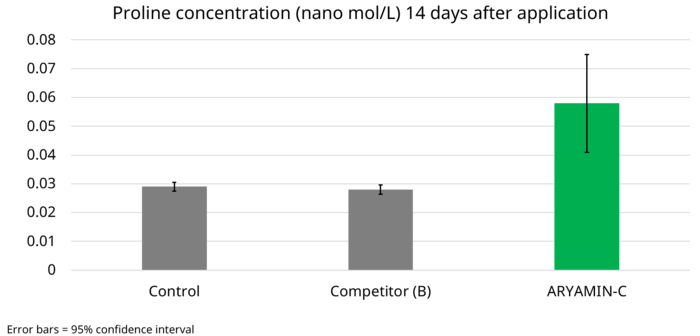The temptation to plant OSR is strong following the recent rainfall and ideal early planting conditions in many regions. To help get the crop off to a good start, UPL has been working to demonstrate the benefits of amino acid biostimulants in stimulating the young plants to grow away from cabbage stem flea beetle.
In 2019, results from several field trials showed UPL’s amino acid biostimulant ARYAMIN-C improved vigour and growth rates which helped offset the feeding rate of the hungry flea beetles. The trials showed consistent yield improvements of up to 14% when applied to crops being grazed by flea beetle in that autumn.
Separate field trials at stem extension stage on crops suffering from larvae damage this spring showed that ARYAMIN-C gave yield benefits of 5% from a single dose compared to untreated, by aiding recovery and new growth. This was more than any insecticide or nutritional product tested at this timing.
To better understand the results seen in the field, UPL commissioned some lab experiments to look deeper at what was going on inside the plant.
The experiments compared leaf analysis of plants treated with ARYAMIN-C to a leading competitor product. ARYAMIN-C is a foliar amino acid product containing 7 key amino acids and is specially formulated to give high concentrations of glutamic acid and proline. Whilst both products improved the chlorophyll content, the products were worlds apart when the amino acid content of the leaf tissue is analysed.
Plants treated with ARYAMIN-C presented levels of proline twice that of both the untreated and the competitor amino acid product. Proline is an amino acid with a key role in pathways that are responsible for both mineral chelation and uptake but also optimising metabolism, directly impacting on a plant’s potential for growth. Proline has also been associated with increased Silica uptake which reduces palatability to many insect pests.
Glutamic acid is also very important because it is a pre-cursor to a number of other amino acids. Providing a crop with a ready supply of glutamic acid allows the plant to optimise the levels of other amino acids as required, in order to combat stress factors responsible for compromising production.
UPL’s head of Technical Services Don Pendergrast, said: “Every manufacturer will claim their product performance is the best, but it’s sometimes difficult to prove why that might be. Explaining the reasons behind the field results is critical to unearthing the science behind biostimulants. In this case, using tissue tests really helped to show how the contents of ARYAMIN-C causes it to behave differently in the plant to other blends of amino acids.“




